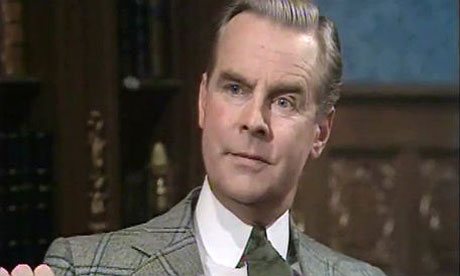Ian Carmichael was born in Hull in June 1920. His father was an optician and was partner in a shop on George Street in Hull that sold jewelry, glass and china wares that started in 1902. The shop branched out into other high quality items and became known as the 'Harrods of Hull'. It remained in the family until it was bought by Woolworth's in 1962. It was later bought from them by the Manager and accountant in 1989 to become a high status shop. Unfortunately the financial timing was bad and they closed down in 1991.

Ian went to school at Scarborough College and hated it. He later went to Bromsgrove School which he liked a little better. His family reluctantly paid for him to attend RADA and he made his stage debut as a robot in 1939 at the People's Palace at Mile End. WWII intervened and he joined the Royal Armoured Corp and saw service in Normandy. He lost the end of a finger when a Valentine tank hatch dropped on him. By the time he left the Army in 1947 he had attained the rank of Major.





Carmichael's Store on George Street, Hull.
Ian went to school at Scarborough College and hated it. He later went to Bromsgrove School which he liked a little better. His family reluctantly paid for him to attend RADA and he made his stage debut as a robot in 1939 at the People's Palace at Mile End. WWII intervened and he joined the Royal Armoured Corp and saw service in Normandy. He lost the end of a finger when a Valentine tank hatch dropped on him. By the time he left the Army in 1947 he had attained the rank of Major.

Ian Carmichael.
Carmichael appeared in many films after the war such as Betrayal with Clark Gable in 1954 and the Colditz Story 1955. He made many Boulting Bros. films with Peter Sellers and Terry Thomas such as Privates Progress 1956, Brothers in Arms 1957 and I'm All Right Jack 1959.
In the 1960's and 70's he moved into television and was successful with roles as P.G. Wodehouse's Bertie Wooster and Dorothy L. Sawyers Lord Peter Wimsey. He wrote his autobiography 'Will the Real Ian Carmichael...' in 1979.

Ian Carmichael as Lord Peter Wimsey.

Ian Carmichael as Bertie Wooster.
Carmichael also appeared in Wives and Daughters, Heartbeat and The Royal until a year before his death.
Ian Carmichael receiving his OBE given in the Queen's Birthday Honours List in 2003.
He died at his home in the Esk Valley in North Yorkshire. He was married for forty years to his first wife who died in 1983 Jean Maclean. They had two daughters Lee and Sally. He married his second wife Kate Fenton, an English novelist and radio producer. He died of natural causes at age 89 in February 2010.














